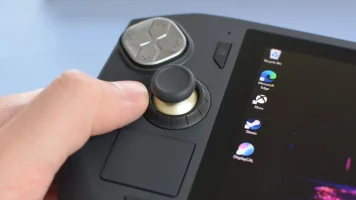General Information
Zotac, known for quality graphics cards, has entered the handheld gaming PC arena with the Zone. As fatigue sets in for some in this market, the Zone stands out, particularly as a rival to the Steam Deck OLED. It's the first real competitor to feature a similarly vibrant AMOLED display, which is truly eye-catching.
Like Zotac's GPUs, the Zone is bulkier than some might prefer but well-built. It combines a stunning screen with numerous input options and performance that outpaces the Deck. However, its high cost and significant battery drain make it more of a niche device than a mainstream portable.
This specialized approach is intentional. The controls are a standout feature, with concave Hall effect thumbsticks, a clicky D-pad, and adjustable triggers reminiscent of high-end controllers like the Xbox Elite or Razer Wolverine V3 Pro. These elements give the Zone unparalleled input quality and versatility in the handheld PC market. It goes further by including dual trackpads, similar to the Steam Deck but with actual click mechanisms instead of haptic feedback. This dual-pad setup makes navigating Windows 11 much easier compared to thumbstick-only devices like the Asus ROG Ally and Ally X, or even the single-pad Lenovo Legion Go.
A clever addition is the radial dials around each stick, which can adjust screen brightness, speaker volume, or the RGB strip brightness on the back. While these settings can be changed through other means, including dedicated volume buttons, the ability to make adjustments without moving your hands from their normal positions is quite useful. One minor gripe is that these dials can't control more settings, such as thumbstick and trackpad sensitivity.
While the Zone boasts impressive features, not all are equally practical. The webcam, positioned near the face buttons, seems oddly placed unless you're planning to stream with an unflattering angle. The trade-off for these extra features is noticeable weight; at 714g, it's heavier than the 640g Steam Deck OLED and even surpasses its official 692g spec. It's also thicker, though not as wide as the Deck.
However, this heft contributes to a solid build quality. The extra depth may benefit the main chip, an AMD Ryzen 7 8840U, typically found in laptops. While not as quiet as the Deck OLED, the Zone's fan noise during gameplay is easily masked by its speakers, and the grips remain comfortably cool.
Using a laptop processor in a handheld can be challenging, as MSI discovered with their Claw. Despite its catchy name, the Claw's Intel CPU proved unsuitable, leading to a quick redesign announcement. The Zone, however, seems to have struck the right balance, with its integrated Radeon 780M graphics delivering top-tier benchmark results.
Comparing 1080p performance to the Steam Deck's 800p, the Zone either outperforms or matches it. At 720p, Zotac's handheld outpaces all competitors, even surpassing the ROG Ally X with its 24GB memory.
This extra power allows games that barely maintain 30fps on the Steam Deck to run smoother or with higher settings on the Zone. For instance, Metaphor: ReFantazio, which requires minimum settings for 30fps at 800p on the Deck, achieves over 35fps at 1080p on Intermediate quality with the Zone. While 1080p is too demanding for Horizon Forbidden West, the Zone can maintain over 30fps at 720p with Low quality and FSR 3.1 on Performance mode, or 45-60fps with frame generation. In contrast, the Steam Deck OLED struggles to reach 30fps even with FSR on Ultra Performance.
The Zone's performance edge is clear, offering smoother gameplay and higher visual fidelity across various titles. This capability sets it apart in the handheld gaming market, potentially justifying its premium price for enthusiasts seeking top-tier portable performance. While it may not be the lightest option, its power-to-portability ratio is impressive, making it a compelling choice for those prioritizing performance over absolute mobility.
Despite its impressive capabilities, the Zone isn't a universal performance upgrade. Demanding titles like Warhammer 40,000: Space Marine 2 and the Silent Hill 2 remake still struggle to maintain 30fps at 720p, even with extensive upscaling. These games might represent the next challenge for handheld devices, possibly requiring the "generational leap" Valve anticipates. However, the Zone's ability to run less demanding games more smoothly, especially with its 120Hz refresh rate, is a notable advantage.
The Zone's display outperforms the Deck OLED's in several aspects. It covers 100% of the sRGB gamut, slightly surpassing the Deck's 93.8% coverage. The Deck OLED does edge out in peak brightness (984 cd/m² vs. 916 cd/m²), while both share the infinite contrast ratio typical of OLED screens. The Zone's higher resolution and refresh rate give it an overall edge, but practical usability is a close contest.
The Steam Deck OLED has some practical advantages. Its superior anti-glare coating makes it more comfortable to use in bright light. It also handles HDR more effectively, automatically enabling it for compatible games. The Zone, running Windows, requires manual HDR activation, which can negatively impact non-HDR content. Oddly, the Zone only supports HDR when plugged in, limiting its usefulness as a portable device.
SteamOS generally offers a better software experience than Windows on a handheld. While Windows supports all game launchers and anti-cheat systems (some of which still challenge the Deck), SteamOS provides a more streamlined, handheld-friendly interface. The Zone's trackpads help with navigation, but using Windows on a small screen remains less intuitive than the gamepad-optimized SteamOS.
In essence, while the Zone boasts impressive specs and performance capabilities, it faces practical challenges in fully utilizing its potential. Its ability to run mid-range games more smoothly is a clear benefit, but the limitations in HDR functionality and the complexities of using Windows on a handheld device somewhat temper its advantages. The Steam Deck OLED, with its more refined software experience and practical screen features, presents strong competition despite lower raw performance. Ultimately, the choice between these devices may come down to individual priorities: raw power versus overall user experience in a portable gaming system.
Zotac's ONE utility aids the Zone, offering a combined game launcher and Zone-specific tools, similar to ROG Ally's Armory Crate. While it provides useful features like an easy input rebind menu, it falls short of SteamOS's capabilities. The overlay's limited options make SteamOS look complex in comparison.
Unfortunately, the Zone isn't bug-free. While not as problematic as the ROG Ally X at launch, it has display issues with certain games. Horizon Zero Dawn had problems from the start, and Silent Hill 2 encountered a black screen issue when changing resolution. These problems persisted despite restarts and driver reinstalls, suggesting Zotac needs to address them.
This highlights a common issue with Steam Deck alternatives: they often boast better specs and features but lack practicality. Battery life is a prime example. Unlike Steam Decks, the Zone doesn't optimize power for less demanding games. With 50% brightness and volume, it lasted about 1 hour 45 minutes across Forza Horizon 5, Elden Ring, and Portal 2. In contrast, the Steam Deck OLED managed 5 hours 48 minutes in Portal 2 and 2 hours 14 minutes in Elden Ring. Even the ROG Ally X outperforms the Zone, lasting 2 hours 55 minutes in Forza.
While battery life isn't everything for a handheld, it's crucial for portability. The Zone's short charging cable further limits its usability when plugged in, as you'd need to sit right next to a power outlet to play while charging. This also makes HDR gaming less feasible.
Steam Deck alternatives often struggle to balance power and practicality. The Zone, like others, offers faster performance and more hardware features but falls short in user-friendliness. This extends to battery life, where it fails to match the efficiency of Steam Decks or even the ROG Ally X.
For a portable device, endurance is key. The Zone's consistent but short battery life across different games (around 1 hour 45 minutes) pales in comparison to the Steam Deck OLED's varied performance (5 hours 48 minutes for Portal 2, 2 hours 14 minutes for Elden Ring). Even the ROG Ally X outlasts the Zone significantly.
While it's unfair to judge a handheld solely on battery life, it's a critical factor for portable gaming. The Zone's limitations in this area, coupled with its impractical charging setup, hinder its appeal as a truly portable device. The short USB-C cable restricts gameplay while charging to situations where you're right next to a power source, further limiting its HDR capabilities.
These issues underscore the ongoing challenge faced by Steam Deck competitors: balancing advanced features with practical usability. While they often boast impressive specs, they frequently fall short in delivering a seamless, user-friendly experience that matches the Steam Deck's practicality.
The Zone doesn't come with a case, which feels stingy for a device priced at £850 – £50 more than the ROG Ally X and nearly £400 above the base Steam Deck OLED. While its top-tier game performance and high-quality inputs justify the cost to some extent, the price tag still raises eyebrows. For £850, you'd expect the cream of the crop, but in terms of software and battery life, the Zone is more middle-of-the-road.
However, its performance and controls are undeniably excellent, and despite some HDR issues, the AMOLED screen is still great for gaming. So, how should we evaluate it?
The answer depends on how you balance the trade-off between frame rates and practicality. There may be gamers out there who've been unimpressed by the power of portable PCs so far – for them, the Zone, with its ability to outperform both the Steam Deck and ROG Ally X, could be the answer they've been waiting for. Even if it's a case of burning bright but burning out quickly.
On the other hand, the Steam Deck OLED offers a more balanced package. It's not as powerful, true, but it's nearly half the price of the Zone while being more user-friendly and lasting much longer. This conclusion might sound lukewarm, but after reviewing several "pricier but faster and fancier than Steam Deck" handheld PCs, there are only so many ways to express the same idea. Perhaps that's where the sense of fatigue comes from.








